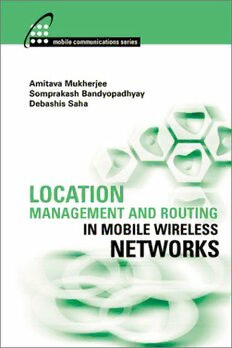
Location Management and Routing in Mobile Wireless Networks PDF
Preview Location Management and Routing in Mobile Wireless Networks
Y L F M A E T Team-Fly® Location Management and Routing in Mobile Wireless Networks ForacompletelistingoftheArtechHouseMobileCommunicationsLibrary, turntothebackofthisbook. Location Management and Routing in Mobile Wireless Networks Amitava Mukherjee Somprakash Bandyopadhyay Debashis Saha Artech House Boston • London www.artechhouse.com LibraryofCongressCataloging-in-PublicationData Mukherjee,Amitava,1959– Locationmanagementandroutinginmobilewirelessnetworks/AmitavaMukherjee, SomprakashBandyopadhyay,DebashisSaha. p.cm.—(ArtechHousemobilecommunicationsseries) Includesbibliographicalreferencesandindex. ISBN1-58053-355-8(alk.paper) 1.Wirelesscommunicationsystems—Location. 2.Wirelesscommunicationsystems— Management. 3.Routers(Computernetworks)I.Bandyopadhyay,Somprakash,1957– II.Saha,Debashis,1965– III.Title. IV.Series. TK5103.2.M852003 621.382—dc21 2003041889 BritishLibraryCataloguinginPublicationData Mukherjee,Amitava,1959– Locationmanagementandroutinginmobilewirelessnetworks.—(ArtechHousemobilecom- municationsseries) 1.Mobilecommunicationsystems I.Title II.Bandyopadhyay,Somprakash,1957– III.Saha,Debashis,1965– 621.3’8456 ISBN1-58053-355-8 CoverdesignbyYekaterinaRatner ©2003ARTECHHOUSE,INC. 685CantonStreet Norwood,MA02062 All rights reserved. Printed and bound in the United States of America. No part of this book maybereproducedorutilizedinanyformorbyanymeans,electronicormechanical,including photocopying,recording,orbyanyinformationstorageandretrievalsystem,withoutpermission inwritingfromthepublisher. Alltermsmentionedinthisbookthatareknowntobetrademarksorservicemarkshavebeen appropriatelycapitalized.ArtechHousecannotattesttotheaccuracyofthisinformation.Useof aterminthisbookshouldnotberegardedasaffectingthevalidityofanytrademarkorservice mark. InternationalStandardBookNumber:1-58053-355-8 LibraryofCongressCatalogCardNumber:2003041889 10987654321 Contents Preface xi Acknowledgments xv PartI:CellularNetworks 1 Introduction 1 1.1 MobileWirelessNetworks 5 1.2 CellularNetworks 6 1.2.1 CellularNetworkStandards 7 1.2.2 CellularArchitecture 8 1.2.3 MediumAccess 9 1.3 AdHocWirelessNetworks 10 1.4 LocationManagement 11 1.4.1 LocationUpdatingandPaging 11 1.4.2 MobilityModels 12 1.4.3 LocationTracking 13 1.4.4 RadioResourceManagement 13 1.5 WirelessRoutingTechniques 13 References 15 v vi LocationManagementandRoutinginMobileWirelessNetworks 2 MobilityIssues 17 2.1 Introduction 17 2.2 MobilityModels 18 2.2.1 FluidFlowModel 18 2.2.2 DiffusionModel 22 2.2.3 GravityModel 22 2.2.4 RandomWalkModel 23 2.3 Mobilityin3GSystems 26 2.3.1 MetropolitanMobility 26 2.3.2 NationalMobilityModel 28 2.3.3 InternationalMobilityModel 29 References 29 3 RadioResourceManagement 31 3.1 RadioPropagation 32 3.1.1 PathLoss 33 3.1.2 ShadowingEffects 35 3.1.3 Reciprocity 35 3.1.4 IndoorWireless 37 3.2 RadioResource(SpectrumAllocation) 37 3.2.1 RadioFrequencySpectrumAllocation 38 3.2.2 InternationalAllocations 38 3.2.3 FinancingforSpectrumManagement 39 3.2.4 SpectrumMonitoringandEnforcement 39 3.2.5 GSMFrequencies 41 3.2.6 IMT-2000(Third-Generation)CoreFrequencyBand 41 3.2.7 IMT-2000(Third-Generation)ExtensionBands 42 3.3 RRM 43 3.3.1 RRMProblem 43 3.3.2 ChannelAllocationandAssignment 46 3.3.3 SchemesforCA 47 3.3.4 TransmitterPowerControl 50 3.4 HandoffProcess 52 3.4.1 Network-ControlledHandoff(HardHandoff) 52 Contents vii 3.4.2 Mobile-ControlledHandoff(SoftHandoff) 53 3.4.3 HandoffPrioritizingSchemes 55 3.5 ManagingResourceAllocation 55 3.5.1 CAC 56 3.5.2 QoS 58 3.6 EmergingRRMTechniques 60 3.6.1 CellPartitioning 60 3.6.2 MultilayeredArchitecture 61 3.6.3 SoftwareRadio 61 3.7 IntegratedRRM 63 3.8 Summary 65 References 67 4 LocationManagement 69 4.1 LocationUpdate 71 4.1.1 LocationUpdateStaticStrategies 72 4.1.2 LocationUpdateDynamicStrategies 72 4.2 Paging 75 4.2.1 BlanketPaging 75 4.2.2 DifferentPagingProcedures 77 4.3 IntelligentPagingScheme 78 4.3.1 SequentialIntelligentPaging 81 4.3.2 PSIP 82 4.3.3 ComparisonofPagingCosts 83 4.4 MorePagingSchemes 84 4.4.1 ReversePaging 85 4.4.2 SemireversePaging 86 4.4.3 UniformPaging 86 4.5 IntersystemPaging 87 4.6 IPMicromobilityandPaging 88 4.7 LocationManagement 89 4.7.1 WithoutLocationManagement 90 4.7.2 ManualRegistrationinLocationManagement 90 viii LocationManagementandRoutinginMobileWirelessNetworks 4.7.3 AutomaticLocationManagementUsingLA 91 4.7.4 Memoryless-BasedLocationManagementMethods 91 4.7.5 Memory-BasedLocationManagementMethods 92 4.7.6 LocationManagementinNext-GenerationSystems 93 4.8 LAPlanning 97 4.8.1 Two-StepApproach 97 4.8.2 LAPlanningandSignalingRequirements 107 4.9 Conclusion 109 References 109 PartII:AdHocWirelessNetworks 5 Overview 117 5.1 CharacteristicsofAdHocNetworks 117 5.2 ThreeFundamentalDesignChoices 118 5.2.1 FlatVersusHierarchicalArchitecture 119 5.2.2 ProactiveVersusReactiveRouting 120 5.2.3 MediumAccessProtocol 121 References 123 6 MACTechniquesinAdHocNetworks 125 6.1 MACProtocolswithOmnidirectionalAntennas 125 6.2 MACProtocolswithDirectionalAntennas 128 6.3 Discussions 132 References 133 7 RoutingProtocolsinAdHocWirelessNetworks 135 7.1 Introduction 135 7.2 UnicastRoutingProtocolsinAdHocNetworks 138 7.2.1 ProactiveRoutingProtocols 138 7.2.2 ReactiveRoutingProtocols 142 7.2.3 AMobileAgent-BasedProtocolforTopology DiscoveryandRouting 154 7.2.4 Power-AwareRoutingProtocolsinAdHocNetworks 158 Contents ix 7.2.5 OtherRoutingProtocols 163 7.3 MulticastRoutingProtocolsinAdHocNetworks 165 7.4 PerformanceComparisonsofUnicastand MulticastRoutingProtocols 168 7.4.1 PerformanceComparisonsof MajorUnicastRoutingProtocols 168 7.4.2 PerformanceComparisonsof MajorMulticastRoutingProtocols 170 7.5 Discussion 170 References 172 PartIII:FutureIssues 8 RoutinginNext-GenerationWirelessNetworks 179 8.1 UMTSAll-IPNetworks 179 8.2 RoutinginDistributedWirelessSensorNetworks 182 8.2.1 Introduction 182 8.2.2 SensorNetworks 182 8.2.3 TopologyMaintenanceandSensorDeployment 183 8.2.4 Routing 184 8.3 PervasiveRouting 186 References 189 9 Conclusion 191 ListofAcronyms 195 AbouttheAuthors 203 Index 205
